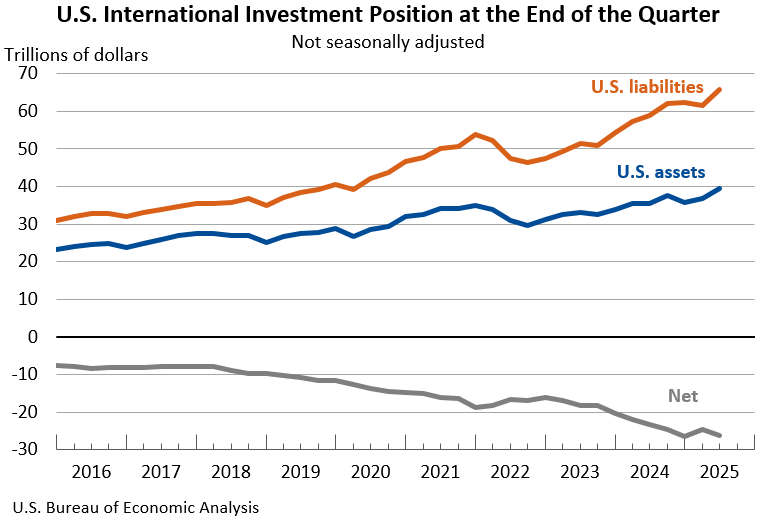Notice
Due to a lapse in appropriations, this website is not being updated.
Bureau of Economic Analysis
U.S. International Investment Position, 2nd Quarter 2025
The U.S. net international investment position, the difference between U.S. residents’ foreign financial assets and liabilities, was -$26.14 trillion at the end of the second quarter of 2025, according to statistics released today by the U.S. Bureau of Economic Analysis. Assets totaled $39.56 trillion, and liabilities were $65.71 trillion. At the end of the first quarter, the net investment position was -$24.65 trillion (revised).
Principal Federal Economic Indicators
Noteworthy
The Latest
Gross Domestic Product, 1st Quarter 2021 (Second Estimate); Corporate Profits, 1st Quarter 2021 (Preliminary Estimate)
Real gross domestic product (GDP) increased at an annual rate of 6.4 percent in the first quarter of 2021, reflecting the continued economic recovery, reopening of establishments, and continued government response related to the COVID-19 pandemic. The increase was the same rate as the “advance” estimate released in April. In the first quarter, government assistance payments, such as direct economic impact payments, expanded unemployment benefits…
Gross Domestic Product for the U.S. Virgin Islands (USVI), 2019
The estimates of GDP for the U.S. Virgin Islands show that real GDP—GDP adjusted to remove price changes— increased 2.2 percent in 2019 after increasing 1.6 percent in 2018.
The increase in real GDP reflected increases in private fixed investment, exports, and consumer spending. These increases were partly offset by decreases in inventory investment and government spending. Imports, which are a subtraction item in the calculation of…
Gross Domestic Product for the U.S. Virgin Islands (USVI), 2019
The estimates of GDP for the USVI show that real GDP—GDP adjusted to remove price changes—increased 2.2 percent in 2019 after increasing 1.6 percent in 2018. This release also includes the results of a comprehensive update of the territorial economic accounts.
BEA Updates Tool for Economic Impact Studies
How would expanding a community college, building a new factory, or increasing government spending on roads impact your local economy? BEA has a tool that can help answer questions like these.
Local planners, businesspeople, and policymakers use the Regional Input-Output Modeling System to predict the potential economic impacts of a variety of projects and events, even natural disasters like hurricanes. The modeling system, known as…
March 2021 Trade Gap is $74.4 Billion
The U.S. monthly international trade deficit increased in March 2021 according to the U.S. Bureau of Economic Analysis and the U.S. Census Bureau. The deficit increased from $70.5 billion in February (revised) to $74.4 billion in March, as imports increased more than exports. The previously published February deficit was $71.1 billion. The goods deficit increased $3.6 billion in March to $91.6 billion. The services surplus decreased $0.3…
U.S. International Trade in Goods and Services, March 2021
The U.S. monthly international trade deficit increased in March 2021 according to the U.S. Bureau of Economic Analysis and the U.S. Census Bureau. The deficit increased from $70.5 billion in February (revised) to $74.4 billion in March, as imports increased more than exports. The previously published February deficit was $71.1 billion. The goods deficit increased $3.6 billion in March to $91.6 billion. The services surplus decreased $0.3 billion…
Personal Income and Outlays, March 2021
Personal income increased $4.21 trillion, or 21.1 percent at a monthly rate, while consumer spending increased $616.0 billion, or 4.2 percent, in March. Economic impact payments established by the American Rescue Plan Act of 2021, which was enacted on March 11, 2021, were distributed. In addition to presenting estimates for March 2021, these highlights provide comparisons to February 2020, the last month before the onset of the COVID-19…
Personal Income and Outlays, March 2021
Personal income increased $4.21 trillion, or 21.1 percent at a monthly rate, while consumer spending increased $616.0 billion, or 4.2 percent, in March. Economic impact payments established by the American Rescue Plan Act of 2021, which was enacted on March 11, 2021, were distributed.
Gross Domestic Product, First Quarter 2021
Real gross domestic product increased at an annual rate of 6.4 percent in the first quarter of 2021, reflecting the continued economic recovery, reopening of establishments, and continued government response related to the COVID-19 pandemic. In the first quarter, government assistance payments, such as direct economic impact payments, expanded unemployment benefits, and Paycheck Protection Program loans, were distributed to households…
Gross Domestic Product, First Quarter 2021 (Advance Estimate)
Real gross domestic product (GDP) increased at an annual rate of 6.4 percent in the first quarter of 2021, reflecting the continued economic recovery, reopening of establishments, and continued government response related to the COVID-19 pandemic. In the first quarter, government assistance payments, such as direct economic impact payments, expanded unemployment benefits, and Paycheck Protection Program loans, were distributed to households and…




